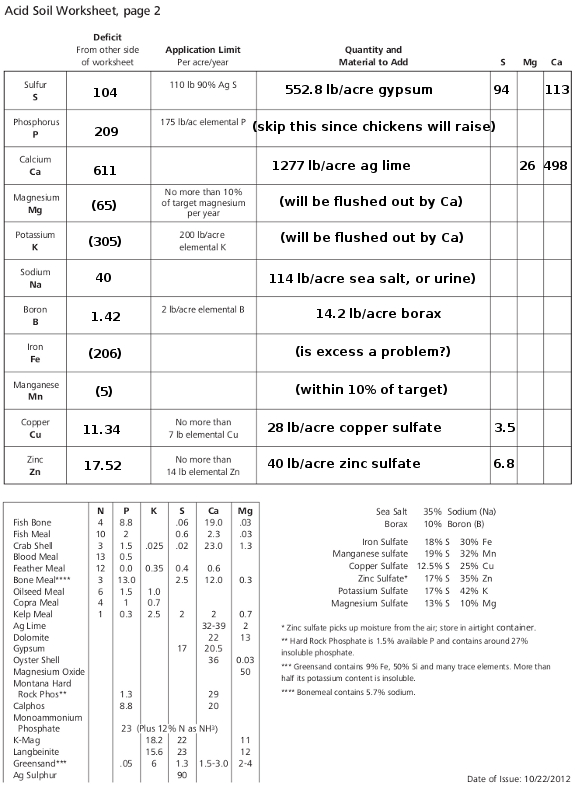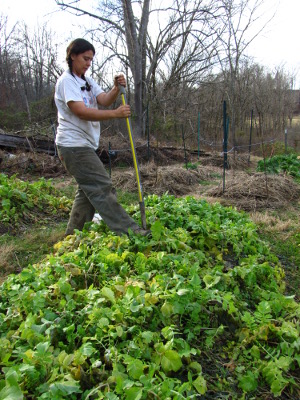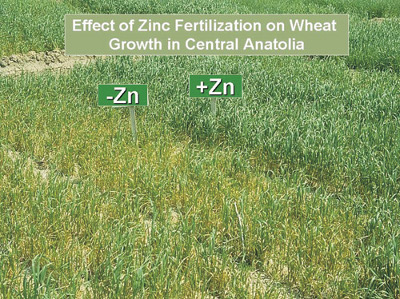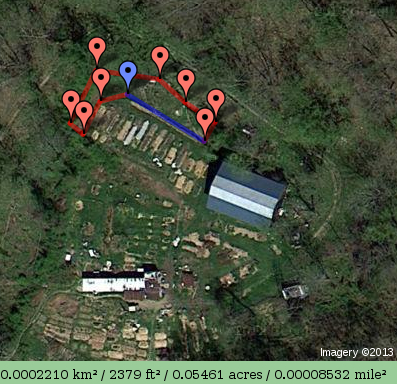
Using Solomon's worksheets to determine soil additives

The second page of Solomon's soil worksheet shows how to create a unique
prescription of additives to get your soil back in balance. Once
again, I prefer a spreadsheet to do my math for me, but I'll work
through the prescription for yesterday's soil sample to help you
understand the process.
The first step just
consists of copying the numbers from the last column of the
other side of the worksheet to the first column of this
worksheet. Anything within 10% of the target amount can be left
alone, but we'll need to come up with a plan to decrease larger
excesses and fill up larger deficits. To do so, choose amendments
from chapter six of The
Intelligent Gardener
and add amounts until the final application rate of each element comes
out the way you want it to.
 It's
usually best to start at the bottom of the chart since Solomon
recommends using sulfate fertilizers to address any deficiencies in
iron, manganese, copper, and zinc. The sulfur that these
fertilizers bring along for the ride will decrease the amount of sulfur
you'll need to add at the top of the chart in the form of ag sulfur or
gypsum. Solomon has included a handy reference chart at the
bottom of the worksheet showing the percent of each element in various
fertilizers, and the last three columns help you keep track of how much
sulfur, magnesium, and calcium come along for the ride in fertilizers
intended for other purposes.
It's
usually best to start at the bottom of the chart since Solomon
recommends using sulfate fertilizers to address any deficiencies in
iron, manganese, copper, and zinc. The sulfur that these
fertilizers bring along for the ride will decrease the amount of sulfur
you'll need to add at the top of the chart in the form of ag sulfur or
gypsum. Solomon has included a handy reference chart at the
bottom of the worksheet showing the percent of each element in various
fertilizers, and the last three columns help you keep track of how much
sulfur, magnesium, and calcium come along for the ride in fertilizers
intended for other purposes.
So, for zinc, you'll
notice I'm 17.52 lb/acre short, but Solomon limits applications each
year to 14 lb/acre. To get that 14 lb/acre, I divide 14 by .35
(the percent of elemental zinc in zinc sulfate, shown in the table at
the bottom of the worksheet), and come up with an application rate of
40 pounds per acre of zinc sulfate. I multiply that by .17 to
come up with the pounds per acre of sulfur that will come along for the
ride, and insert the result (6.8) in the sulfur column as a reminder to
myself that I've already met part of the sulfur demand.
If I were going to apply
phoshorus to this pasture, I'd hit this row next since most sources of
phosphorus also bring along some sulfur. However, I estimate our
ten chickens
will add 47 pounds per acre of phosphorus to these pastures each year,
and I don't mind a slow-but-steady accumulation of phosphorus, so I'm
not going to add any extra. (All of my vegetable garden areas
actually have an excess of phosphorus, suggesting that topdressing with
a layer of horse manure would be another good way to increase the
phosphorus levels in the chicken pasture while also increasing the low
organic matter, so I may consider that if we have extra manure in the
spring.)
 Now I head to the top of the
chart and decide on the type of sulfur amendment. This pasture is
acidic and low on calcium, so I don't want to add ag sulfur (which
would lower the pH further and leach calcium). Instead, I settle
on gypsum. I've already got 10.3 lb/acre sulfur coming with my
zinc and copper fertilizers, so I only need to add another 94 lb/acre
elemental sulfur. Gypsum is 17% sulfur, so I divide 94 by .17 and
get 553 lb/acre as my application amount.
Now I head to the top of the
chart and decide on the type of sulfur amendment. This pasture is
acidic and low on calcium, so I don't want to add ag sulfur (which
would lower the pH further and leach calcium). Instead, I settle
on gypsum. I've already got 10.3 lb/acre sulfur coming with my
zinc and copper fertilizers, so I only need to add another 94 lb/acre
elemental sulfur. Gypsum is 17% sulfur, so I divide 94 by .17 and
get 553 lb/acre as my application amount.
Gypsum also contains
20.5% calcium, so I multiply 553 by .205 and get 113 lbs/acre elemental
calcium, which I add to the far right column as a note to myself.
Subtract that from the 611 pounds of calcium in which my soil is
deficient, and I need 498 more pounds per acre elemental calcium, or
1,277 lb/acre ag lime (assuming a calcium content of 39%).
(Dolomite would be a bad choice for my calcium source since I have too
much magnesium in my soil already, but if I had a cheap source of
oyster shells, they could work to fill this deficit just as well as ag
lime.)
The combination of
gypsum and calcium will flush out excess magnesium and potassium from
the soil, but I'll want to test again at during the same month (and
with the same lab) next year to make sure the soil is getting more in
balance. If I lived in a dry area, I'd also want to water the
soil heavily after applying gypsum to ensure the excess cations moved
out, but lack of water isn't a problem on our farm.
Meanwhile, Solomon's
prescription calls for 114 lb/acre sea salt to deal with my sodium
deficiency, but I'm figuring I can just add urine to increase the
sodium levels. (I'm not so sure it makes sense to try to increase
these levels right now anyway since sodium is lower on the totem pole
than potassium and magnesium and will presumably be washed away at the
same time those cations are.) Finally, 14.2 lb/acre of borax
rounds out the soil prescription.
 The
final bit of math is to figure
out how large the garden area is and to calculate an actual
amount of each fertilizer to add to the pasture. These two little
pastures add up to a twentieth of an acre, so I'd multiply all of my
amounts by 0.05.
The
final bit of math is to figure
out how large the garden area is and to calculate an actual
amount of each fertilizer to add to the pasture. These two little
pastures add up to a twentieth of an acre, so I'd multiply all of my
amounts by 0.05.
Solomon recommends
mixing anions (sulfur, phosphorus, and nitrogen) into compost before
applying since humus hangs onto these negatively charged particles and
releases them slowly into the soil. Boron is an anion, but it's
very easy to accidentally apply too much of this nutrient, so the best
option here is to mix the proper amount into water and spray it evenly
on the ground. The cations (including copper and zinc)
can be mixed together and spread across the soil surface (or dug in if
you till).
Next week, I'm going to
continue this lunchtime series with analysis of other parts of our
farm, but I do want to add a caveat here. Solomon recommends
adding some fertilizers which aren't organically approved and/or which
might cause short-term harm to your soil microorganisms. Gypsum
and lime seem to be relatively innocuous (as long as you check
application rates carefully), but I need to do some more research
before deciding how I feel about borax, copper sulfate, and zinc
sulfate. On a small scale, choosing dynamic accumulators that
concentrate the same nutrients and using them as part of your compost
pile could be a more harmless solution, and some people use rock dusts
to boost micronutrients (although Solomon thinks they don't provide
enough minerals to make the dusts worth your while). I'm curious
to hear from anyone who has done more research than I have about these
amendments.
Thanks for hanging in
there through all this math. Hopefully the analyses week after next will
have fewer numbers and will help broaden these ideas out so you can see
the big picture. (Next week we're taking a break to talk about cover crops.)
This
post is part of our The Intelligent
Gardener lunchtime series.
Read all of the entries:
|
Want more in-depth information? Browse through our books.
Or explore more posts by date or by subject.
About us: Anna Hess and Mark Hamilton spent over a decade living self-sufficiently in the mountains of Virginia before moving north to start over from scratch in the foothills of Ohio. They've experimented with permaculture, no-till gardening, trailersteading, home-based microbusinesses and much more, writing about their adventures in both blogs and books.
Want to be notified when new comments are posted on this page? Click on the RSS button after you add a comment to subscribe to the comment feed, or simply check the box beside "email replies to me" while writing your comment.
- Remove comment
